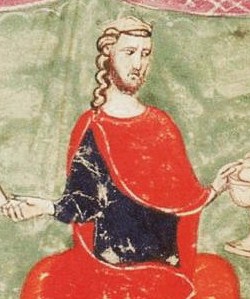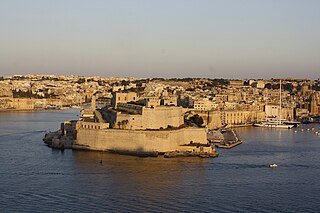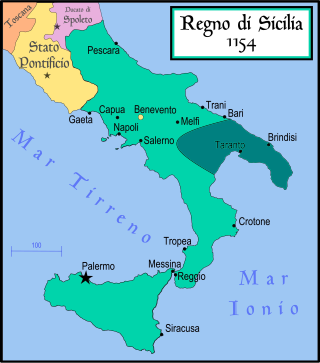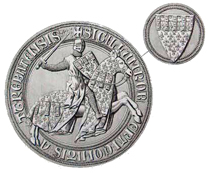Sources
- Rossi, Vito Pasquale (1985). Uomini Illustri di Lauria. Moliterno: Porfidio.
Richard of Lauria (died 26 February 1266) was an Italian nobleman. He was the father of admiral Roger of Lauria.
He was lord of Lauria from 1254 and Scalea from 1266, and also held fiefs in Basilicata (from 1239) and Calabria. He married Bella Amico, becoming baron of Ficarra.
Roger's daughter married Corrado I Lancia, uncle of king Manfred of Sicily. Under the latter, Richard was Great Justicier and War Captain of Bari.
Richard died while fighting alongside Manfred in the Battle of Benevento, in 1266.

Charles I, commonly called Charles of Anjou or Charles d'Anjou, was King of Sicily from 1266 to 1285. He was a member of the royal Capetian dynasty and the founder of the House of Anjou-Sicily. Between 1246 and 1285, he was Count of Provence and Forcalquier in the Holy Roman Empire and Count of Anjou and Maine in France. In 1272 he was proclaimed King of Albania, in 1277 he purchased a claim to the Kingdom of Jerusalem, and in 1278 he became Prince of Achaea after the previous ruler, William of Villehardouin, died without heirs.

Year 1266 (MCCLXVI) was a common year starting on Friday of the Julian calendar.

Peter III of Aragon was King of Aragon, King of Valencia, and Count of Barcelona from 1276 to his death. At the invitation of some rebels, he conquered the Kingdom of Sicily and became King of Sicily in 1282, pressing the claim of his wife, Constance II of Sicily, uniting the kingdom to the crown.

Manfred was the last King of Sicily from the Hohenstaufen dynasty, reigning from 1258 until his death. The natural son of the Holy Roman Emperor Frederick II, Manfred became regent over the kingdom of Sicily on behalf of his nephew Conradin in 1254. As regent he subdued rebellions in the kingdom, until in 1258 he usurped Conradin's rule. After an initial attempt to appease Pope Innocent IV he took up the ongoing conflict between the Hohenstaufens and the papacy through combat and political alliances. He defeated the papal army at Foggia on 2 December 1254. Excommunicated by three successive popes, Manfred was the target of a Crusade (1255–66) called first by Pope Alexander IV and then by Urban IV. Nothing came of Alexander's call, but Urban enlisted the aid of Charles of Anjou in overthrowing Manfred. Manfred was killed during his defeat by Charles at the Battle of Benevento, and Charles assumed kingship of Sicily.

The Battle of Malta took place on 8 July 1283 in the entrance to the Grand Harbour, the principal harbour of Malta, as part of the War of the Sicilian Vespers. An Aragonese fleet of galleys, commanded by Roger of Lauria, attacked and defeated a fleet of Angevin galleys commanded by Guillaume Cornut and Bartholomé Bonvin.

The Principality of Taranto was a state in southern Italy created in 1088 for Bohemond I, eldest son of Robert Guiscard, as part of the peace between him and his younger brother Roger Borsa after a dispute over the succession to the Duchy of Apulia.

Roger of Lauria (c. 1245 – 17 January 1305), was a Calabrian knight who served the Crown of Aragon as admiral of the Aragonese navy during the War of the Sicilian Vespers. He was probably the most successful and talented naval tactician of the Middle Ages. He is known as Ruggero or Ruggiero di Lauria in Italian and Roger de Llúria in Catalan.

Robert II was the Count of Artois, the posthumous son and heir of Robert I and Matilda of Brabant. He was a nephew of Louis IX of France. He died at the Battle of the Golden Spurs.

Lauria is a town and comune of the province of Potenza, in Basilicata, southern Italy, situated near the borders of Calabria. It is a walled, medieval town on the steep side of a hill, with another portion of municipal territory in the plain below.

The War of the Sicilian Vespers, also shortened to the War of the Vespers, was a conflict waged by several medieval European kingdoms over control of Sicily from 1282 to 1302. The war, which started with the revolt of the Sicilian Vespers, was fought over competing dynastic claims to the throne of Sicily and grew to involve the Crown of Aragon, Angevin Kingdom of Naples, Kingdom of France, and the papacy.

WilliamII was the third son of Frederick III of Sicily and Eleanor of Anjou. He inherited the Duchy of Athens after the death of his elder brother Manfred on 9 November 1317.

Eleanor of Anjou was Queen of Sicily as the wife of King Frederick II of Sicily. She was a member of the Capetian House of Anjou by birth.
Helena Angelina Doukaina was Queen of Sicily as the second wife of King Manfred. Queen Helena was the daughter of Michael II Komnenos Doukas, Despot of Epirus, and Theodora Petraliphaina. Her marriage was an expression of the alliance of her father and the ruler of Sicily against the growing power of the Empire of Nicaea.

Bianca Lancia d'Agliano, was an Italian noblewoman. She was the mistress and later, possibly the last wife of the Hohenstaufen emperor Frederick II. The marriage was conducted while she was on her deathbed, therefore it was considered non-canonical.

Elisabeth of Bavaria was Queen of Germany and Jerusalem from 1246 to 1254 by her marriage to King Conrad IV of Germany.
Bella d'Amichi or Bella d'Amico, was an Italian noble and mother of Roger of Lauria.

Beatrix of Sicily or Beatrice di Sicilia was a Sicilian princess. In 1296 she became Marchioness consort of Saluzzo.
Saba Malaspina was an Italian historian, writer, and clergyman. Born around the mid-13th century in southern Italy, he was from a "Roman family with a strong tradition of support for the papal cause" and was the deacon of the diocese of Mileto. Little is known about his early years and education. His honorific of magister indicates that he studied at a university. In 1275, he collected tithes for crusading on Pope Gregory X's behalf. Around 1283, while serving as the amanuensis of Pope Martin IV, Malaspina began writing the Liber gestorum regum Sicilie; he finished writing his history of Sicily on 29 March 1285, by which time he had already obtained Roman citizenship.